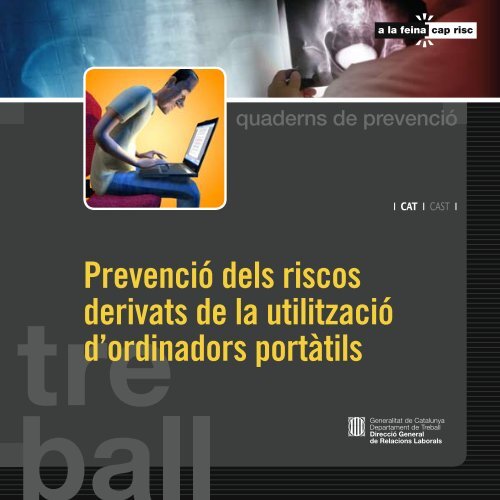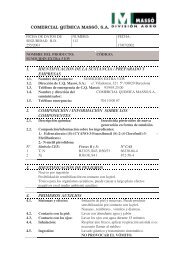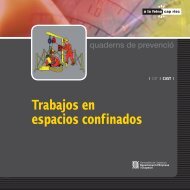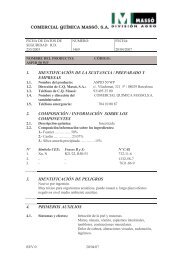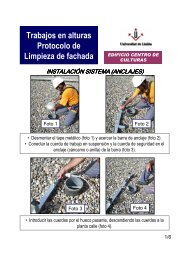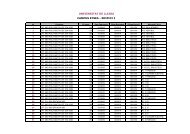Prevenció dels riscos derivats de la utilització d’ordinadors portàtils
Prevenció dels riscos derivats de la utilització d'ordinadors portà tils
Prevenció dels riscos derivats de la utilització d'ordinadors portà tils
You also want an ePaper? Increase the reach of your titles
YUMPU automatically turns print PDFs into web optimized ePapers that Google loves.
qua<strong>de</strong>rns <strong>de</strong> prevencióı CAT ı CAST ı<strong>Prevenció</strong> <strong><strong>de</strong>ls</strong> <strong>riscos</strong><strong><strong>de</strong>rivats</strong> <strong>de</strong> <strong>la</strong> <strong>utilització</strong><strong>d’ordinadors</strong> <strong>portàtils</strong>
Direcció General<strong>de</strong> Re<strong>la</strong>cionsLaboralsSubdirecció General <strong>de</strong> Seguretat i Salut LaboralSepúlveda, 148-150 - 08011 BarcelonaTel. 93 228 57 57www.gencat.cat/a<strong>la</strong>feinacapriscBarcelonaGironaLleidaTarragonaTortosaCentres <strong>de</strong>Seguretat iSalut LaboralPl. d’Eusebi Güell, 4-508034 BarcelonaTel. 93 205 50 01C. <strong>de</strong> l’Església <strong>de</strong>Sant Miquel, 1117003 GironaTel. 972 20 82 16Pol. Ind. El SegreJ. Segura i Farré, 728-B25191 LleidaTel. 973 20 04 00Polígon Camp C<strong>la</strong>rRiu Siurana, 29-B43006 TarragonaTel. 977 54 14 55ServeisTerritorials<strong>de</strong> TreballAlbareda, 2-408004 BarcelonaTel. 93 622 04 49Rutl<strong>la</strong>, 69-7517003 GironaTel. 972 94 04 13General Britos, 325007 LleidaTel. 973 24 86 62J. Baptista P<strong>la</strong>na, 29-3143005 TarragonaTel. 977 23 66 02De <strong>la</strong> Rosa, 943500 TortosaTel. 977 44 81 01InspeccionsProvincials<strong>de</strong> Treball iSeguretat SocialTrav. <strong>de</strong> Gràcia, 30308025 BarcelonaTel. 93 401 30 00Álvarez <strong>de</strong> Castro, 4, 2n17001 GironaTel. 972 20 59 33Riu Besòs, 225001 LleidaTel. 973 21 63 80Vidal i Barraquer, 2043005 TarragonaTel. 977 23 58 25EDICIÓDepartament <strong>de</strong> TreballAUTORSM. Carme Barba GarridoAnna M. Barnés SarràDISSENYIDDIC - Estudi VaquéIL·LUSTRACIÓReversible SCPIMPRESSIÓTECFA GroupDLB-10628-2010AVÍS LEGAL. Aquesta obra està subjecta a una llicència Reconeixement-No Comercial-Sense Obres Deriva<strong>de</strong>s3.0 <strong>de</strong> Creative Commons. Se’n permet <strong>la</strong> reproducció, distribució i comunicació pública sempre que se’n citil’autor i no se’n faci un ús comercial <strong>de</strong> l’obra original ni <strong>la</strong> generació d’obres <strong>de</strong>riva<strong>de</strong>s. La llicència completaes pot consultar a http://creativecommons.org/licenses/by-nc-nd/3.0/es/legalco<strong>de</strong>.caqua<strong>de</strong>rns <strong>de</strong> prevencióPQP PORTA
PREVENCIÓ DELS RISCOS DERIVATS DE LA UTILITZACIÓ D’ORDINADORS PORTÀTILS1IntroduccióAvui en dia l’ordinador portàtil és un equip <strong>de</strong> treballper als trebal<strong>la</strong>dors <strong>la</strong> feina <strong><strong>de</strong>ls</strong> quals implica<strong>de</strong>sp<strong>la</strong>çar-se o atendre diverses esferes <strong>de</strong> <strong>la</strong> sevavida <strong>la</strong>boral, social i familiar.El món <strong>la</strong>boral requereix que els trebal<strong>la</strong>dors i trebal<strong>la</strong>dorespuguin donar respostes més ràpi<strong>de</strong>s en<strong>la</strong> seva tasca, aspecte que només es pot assoliramb les noves tecnologies.Consi<strong>de</strong>rant l’abast <strong>de</strong> l’ús <strong>d’ordinadors</strong> <strong>portàtils</strong>,aquesta publicació està pensada per proporcionarsuggeriments en re<strong>la</strong>ció amb <strong>la</strong> millor <strong>utilització</strong> <strong>de</strong><strong>portàtils</strong> en el context <strong>de</strong> <strong>la</strong> seguretat i <strong>la</strong> salut.Els equips <strong>portàtils</strong> faciliten <strong>la</strong> feina, <strong>la</strong> comunicaciói l’estudi, però també comporten uns <strong>riscos</strong> quees po<strong>de</strong>n prevenir.Tipologia <strong>de</strong> <strong>riscos</strong>: quins son?Els factors <strong>de</strong> risc addicionals que origina <strong>la</strong> <strong>utilització</strong><strong>d’ordinadors</strong> <strong>portàtils</strong> respecte a <strong>la</strong> <strong>utilització</strong><strong>d’ordinadors</strong> convencionals són:La improvisació <strong>de</strong>l lloc <strong>de</strong> treball en una oficinaexterna, en un mitjà <strong>de</strong> transport (avió, tren, autobús),a l’hotel, etc. pot dificultar l’adopció <strong>de</strong>postures <strong>de</strong> treball còmo<strong>de</strong>s o correctes.El disseny integrat <strong>de</strong> <strong>la</strong> pantal<strong>la</strong> i tec<strong>la</strong>t <strong>de</strong> l’ordinadorportàtil no permet ajustar <strong>de</strong> forma convenienti ergonòmica <strong>la</strong> distància <strong>de</strong> <strong>la</strong> personausuària entre el tec<strong>la</strong>t i <strong>la</strong> pantal<strong>la</strong>, <strong>la</strong> qual cosaobliga l’usuari o usuària a adoptar postures força<strong>de</strong>s<strong>de</strong> coll i cap. Alhora, <strong>la</strong> integració <strong>de</strong>l ratolíi el disseny <strong>de</strong>l tec<strong>la</strong>t <strong>de</strong> l’ordinador portàtil (teclesmés juntes i petites) obliga que <strong>la</strong> feina <strong>de</strong>teclejar requereixi <strong>de</strong> més moviments que sónduts a terme en postures força<strong>de</strong>s <strong>de</strong> <strong>la</strong> mà i <strong>de</strong>lcanell.El fet <strong>de</strong> carregar i transportar l’equip <strong>de</strong> treballdurant el <strong>de</strong>sp<strong>la</strong>çament entre diferents centres<strong>de</strong> treball inci<strong>de</strong>ix en una sobrecàrrega muscu<strong>la</strong>rlocalitzada.Mitjançant l’adopció d’una sèrie <strong>de</strong> mesures preventives,que resulten <strong>de</strong> l’anàlisi <strong><strong>de</strong>ls</strong> <strong>riscos</strong> <strong><strong>de</strong>rivats</strong><strong>de</strong> <strong>la</strong> <strong>utilització</strong> <strong>d’ordinadors</strong> <strong>portàtils</strong>, espo<strong>de</strong>n millorar les condicions <strong>de</strong> treball tal com esveurà a continuació.
2PREVENCIÓ DELS RISCOS DERIVATS DE LA UTILITZACIÓ D’ORDINADORS PORTÀTILSI<strong>de</strong>ntificació i localització <strong><strong>de</strong>ls</strong><strong>riscos</strong>: on els trobem?Risc <strong>de</strong>rivat <strong>de</strong> l’exposició a postures força<strong>de</strong>so <strong>de</strong>sviació articu<strong>la</strong>r originat per <strong>la</strong> postura<strong>de</strong> treball. Romandre molt <strong>de</strong> temps assegut enuna postura estàtica fa que s’adoptin posturesforça<strong>de</strong>s sobretot <strong>de</strong>l tronc, coll i extremitats superiors.Fatiga visual. Una il·luminació o contrast ina<strong>de</strong>quat<strong>de</strong> lluminàries originen enlluernaments ireflexos a <strong>la</strong> pantal<strong>la</strong>. A més, s’adopten posturesforça<strong>de</strong>s i restringi<strong>de</strong>s per evitar aquests reflexos.
PREVENCIÓ DELS RISCOS DERIVATS DE LA UTILITZACIÓ D’ORDINADORS PORTÀTILS 3Sobrecàrrega muscu<strong>la</strong>r localitzada a <strong>la</strong> zona<strong>de</strong>l cos que suporta el pes <strong>de</strong>l portàtil (conjuntformat per l’equip, bateria, suports, documents,unitats <strong>de</strong> memòria, etc., que pot superar els 4kg), generalment a l’espatl<strong>la</strong> si s’usa una bossa<strong>de</strong> tipus bandolera, a les extremitats superiors sis’usa una maleta amb ro<strong>de</strong>s per ésser arrossegadao per empènyer i <strong>la</strong> part alta <strong>de</strong> l’esquena sis’usa una motxil<strong>la</strong>.Desviació articu<strong>la</strong>r com el gir i/o flexió <strong>de</strong>lcoll i adaptació continuada <strong>de</strong> <strong>la</strong> visió a diferentsdistàncies, luminàncies i/o contrastos, pelfet d’haver d’ubicar els documents fora <strong><strong>de</strong>ls</strong> anglesvisuals.Risc <strong>de</strong>rivat <strong>de</strong> l’exposició a moviments repetitiusrealitzats durant perío<strong>de</strong>s <strong>de</strong> tempsperllongats, que, units a un entorn <strong>de</strong> treball ina<strong>de</strong>quati uns hàbits incorrectes, po<strong>de</strong>n estar re<strong>la</strong>cionatsamb lesions o incomoditats a les mansi canells.
4PREVENCIÓ DELS RISCOS DERIVATS DE LA UTILITZACIÓ D’ORDINADORS PORTÀTILSMesures preventives:què po<strong>de</strong>m fer?Per reduir les postures força<strong>de</strong>si <strong>la</strong> <strong>de</strong>sviació articu<strong>la</strong>rAjustar l’alçada <strong>de</strong> <strong>la</strong> cadira <strong>de</strong> manera que permetimantenir els avantbraços flexionats fins a90º i recolzats sobre <strong>la</strong> tau<strong>la</strong> sense en<strong>la</strong>irar lesespatlles i, si no hi ha tau<strong>la</strong>, recolzar l’ordinadorsobre el maletí o objecte simi<strong>la</strong>r.Mantenir l’esquena recolzada, en posició assegutsobre els isquions. Les cames han <strong>de</strong>formar un angle <strong>de</strong> 90º. Mantenir recolzats elspeus i les cames <strong>de</strong> manera que facilitem el recolzamentlumbar al seient i evitem compressionsa les cames.Posicionar el portàtil <strong>de</strong> manera que es disposid’espai per recolzar els canells. Trebal<strong>la</strong>r ambels canells en posició neutra, utilitzar un reposacanellsper eliminar tensions muscu<strong>la</strong>rs ievitar <strong>la</strong> flexió o extensió <strong>de</strong>l canell.Seure en posició frontal respecte <strong>de</strong> <strong>la</strong> pantal<strong>la</strong>i, en les tasques que requereixin alternar <strong>la</strong>visualització <strong>de</strong> <strong>la</strong> pantal<strong>la</strong> amb <strong>la</strong> lectura freqüent<strong>de</strong> documents impresos, aquests documentshan d’estar recolzats en un suport entreel tec<strong>la</strong>t i pantal<strong>la</strong> (faristol) o a <strong>la</strong> mateixa pantal<strong>la</strong>(pinça o grapa) que permeti ubicar-los enels angles visuals o <strong>de</strong> gir i/o flexió <strong>de</strong>l col<strong>la</strong>cceptables.Fer <strong>de</strong>scansos freqüents amb exercicis físicsposturals. Resulten més eficaces les pausescurtes (5-8 minuts) i freqüents (60-90 minuts)sempre acompanya<strong>de</strong>s d’estiraments, que l<strong>la</strong>rguesi espaia<strong>de</strong>s.Per al control <strong>de</strong> <strong>la</strong> fatiga visualEs recomana <strong>la</strong> col·locació <strong>de</strong> <strong>la</strong> pantal<strong>la</strong> a unadistància superior a 40 cm respecte <strong><strong>de</strong>ls</strong> ulls <strong>de</strong>l’usuari o usuària.
PREVENCIÓ DELS RISCOS DERIVATS DE LA UTILITZACIÓ D’ORDINADORS PORTÀTILS5La pantal<strong>la</strong> ha d’estar a una altura tal que puguiser visualitzada dins l’espai comprès entre <strong>la</strong>línia <strong>de</strong> visió horitzontal i <strong>la</strong> traçada a 60º sota<strong>la</strong> horitzontal.Es recomana <strong>la</strong> <strong>utilització</strong> d’equips amb pantallesa partir <strong>de</strong> 14” i augmentar <strong>la</strong> mida <strong>de</strong>ltipus <strong>de</strong> lletra emprat per visualitzar.Fer pauses breus, però freqüents, <strong>de</strong> 20 segonscada 20 minuts. El badall i el parpelleig aju<strong>de</strong>na mantenir els ulls lubricats. Re<strong>la</strong>xar <strong>la</strong> vista mirantllocs allunyats, el canvi d’enfocament ajudaa re<strong>la</strong>xar els músculs ocu<strong>la</strong>rs. El palpeig disminueix<strong>la</strong> tensió ocu<strong>la</strong>r, per això s’han <strong>de</strong> cobrirels ulls amb les mans i respirar profundament.La naturalesa reflectora <strong>de</strong> <strong>la</strong> superfície <strong>de</strong> vidre<strong>de</strong> <strong>la</strong> majoria <strong>de</strong> les pantalles fa que siguin moltsusceptibles a <strong>la</strong> generació <strong>de</strong> reflexos. Existei-xen maneres per contro<strong>la</strong>r aquests reflexos:Mitjançant el condicionament <strong>de</strong> l’entorn mediambientalon s’ubica <strong>la</strong> pantal<strong>la</strong>; evitant <strong>la</strong>presència <strong>de</strong> fonts <strong>de</strong> llum susceptibles <strong>de</strong> reflectir-s’hi.Regu<strong>la</strong>r <strong>la</strong> llum natural amb cortines opersianes, evitar situar l’equip <strong>de</strong> cara od’esquena a <strong>la</strong> finestra.Orientar <strong>la</strong> pantal<strong>la</strong> <strong>de</strong> manera que les finestresquedin situa<strong>de</strong>s <strong>la</strong>teralment.Situar l’equip paral·lel als llums <strong>de</strong>l sostre,i reforçar <strong>la</strong> il·luminació sobre el tec<strong>la</strong>t.Mitjançant <strong>la</strong> intervenció en <strong>la</strong> pròpia pantal<strong>la</strong>,escollint mo<strong><strong>de</strong>ls</strong> amb tractament antireflector icapacitat <strong>de</strong> proporcionar bons nivells <strong>de</strong> contrast.
6PREVENCIÓ DELS RISCOS DERIVATS DE LA UTILITZACIÓ D’ORDINADORS PORTÀTILSPer millorar les característiques físiques<strong>de</strong> l’entorn <strong>de</strong> treballL’ordinador portàtil està dissenyat per fer tasquesesporàdiques, no com a eina <strong>de</strong> treballhabitual. Es recomana utilitzar sempre que siguipossible estacions d’acob<strong>la</strong>ment que permetenutilitzar tec<strong>la</strong>t i ratolí perifèrics.La tau<strong>la</strong> <strong>de</strong> treball ha <strong>de</strong> disposar <strong>de</strong> vores arrodoni<strong>de</strong>s,ha <strong>de</strong> ser poc reflectora, ni massac<strong>la</strong>ra ni massa fosca, i dimensionada per col·-locar-hi els elements necessaris.Regu<strong>la</strong>r <strong>la</strong> temperatura i <strong>la</strong> humitat re<strong>la</strong>tiva <strong>de</strong>llloc <strong>de</strong> treball i aïl<strong>la</strong>r-lo <strong>de</strong> contaminació acústica.Quan el lloc <strong>de</strong> treball improvisat és un mitjà <strong>de</strong>transport (tren, avió, autobús, etc.), el p<strong>la</strong> <strong>de</strong> treballs’ha d’ubicar en llocs que permetin llibertat<strong>de</strong> moviments:A l’avió, cal seure davant<strong>la</strong> sortida d’emergència oen seients que tinguin barrarecolza peus; si és uncotxe, cal seure al seient<strong>de</strong>l passatger i limitar eltemps d’ús <strong>de</strong>l portàtil a 30minuts.Elevar l’alçada <strong>de</strong>l p<strong>la</strong> <strong>de</strong>treball, recolzar l’ordinadorsobre el maletí o objecte simi<strong>la</strong>r que permetiubicar <strong>la</strong> pantal<strong>la</strong> dins <strong>la</strong> visual <strong>de</strong>l’usuari.En trens cal utilitzar les taules comunesentre seients i evitar utilitzar les taules adjuntesal darrera <strong><strong>de</strong>ls</strong> seients.Fer pauses sovint i canviar <strong>de</strong> postura, ferexercicis d’estiraments <strong>de</strong> <strong>la</strong> muscu<strong>la</strong>turafatigada i adoptar postures antagòniquesa les mantingu<strong>de</strong>s davant l’ordinador portàtil.Asseure’s allunyats <strong>de</strong> les finestres sensecortines o persianes i que <strong>la</strong> pantal<strong>la</strong> ensquedi perpendicu<strong>la</strong>r a l’entrada <strong>de</strong> llumnatural o entremig <strong><strong>de</strong>ls</strong> punts <strong>de</strong> llum artificial.Si alguna superfície ens provoca enlluernamentso reflexes <strong>la</strong> cobrirem ambalgun material <strong>de</strong> textura mat i <strong>de</strong> colorneutre.
PREVENCIÓ DELS RISCOS DERIVATS DE LA UTILITZACIÓ D’ORDINADORS PORTÀTILS 7Per al transport manual <strong>de</strong> l’equipEl transport manual <strong>de</strong>l conjunt <strong>de</strong> l’equip <strong>de</strong> treballportàtil és preferiblement en motxil<strong>la</strong>, queredueix <strong>la</strong> pressió sobre els braços i distribueixles càrregues uniformement sobre el cos, sempreque el pes <strong>de</strong>l conjunt <strong>de</strong> l’equip portàtil nosuperi el 10% <strong>de</strong>l pes corporal <strong>de</strong> l’usuari i l’alçadaestigui alineada amb el centre <strong>de</strong> gravetat <strong><strong>de</strong>ls</strong>eu cos.Quan es carregui el portàtil en una bossa <strong>de</strong> tipusbandolera, s’ha <strong>de</strong> canviar periòdicament elbraç amb el qual es transporta <strong>de</strong> manera queel pes es reparteixi a banda i banda <strong>de</strong>l cos. Sitambé es transporten maletes, cal equilibrar elpes d’ambdues parts.Escollir els equips <strong>de</strong>l mercat que ofereixen elpes més reduït, utilitzar bateries <strong>de</strong> l<strong>la</strong>rga duradaper evitar el transport <strong>de</strong> cables i transformadoro bé preveure <strong>la</strong> disponibilitat <strong>de</strong> transformadorsestàndard en els centres <strong>de</strong> treball <strong>de</strong><strong>de</strong>stí.Normativa“Llei 31/1995, <strong>de</strong> 8 <strong>de</strong> novembre, <strong>de</strong> prevenció<strong>de</strong> <strong>riscos</strong> <strong>la</strong>borals”. Boletín Oficial <strong>de</strong>l Estado (10noviembre 1995), núm. 269.COMITÉS TÉCNICOS DE NORMALIZACIÓN (CTN);AENOR. Principis ergonòmics a consi<strong>de</strong>rar enel projecte <strong><strong>de</strong>ls</strong> sistemes <strong>de</strong> treball: UNE EN 81-425-91. Madrid: AENOR.COMITÉS TÉCNICOS DE NORMALIZACIÓN (CTN);AENOR. Requisits ergonòmics per a treballsd’oficina amb pantalles <strong>de</strong> visualització <strong>de</strong> da<strong>de</strong>s(PVD).: UNE EN ISO 9241-5. Part 5: Concepció <strong>de</strong>llloc <strong>de</strong> treball i exigències posturals. Madrid: AE-NOR.
8PREVENCIÓ DELS RISCOS DERIVATS DE LA UTILITZACIÓ D’ORDINADORS PORTÀTILSBibliografia i webgrafiaCATALUNYA. GENERALITAT. DEPARTAMENT DETREBALL I INDÚSTRIA. Manual per a <strong>la</strong> i<strong>de</strong>ntificaciói avaluació <strong>de</strong> <strong>riscos</strong> <strong>la</strong>borals. Barcelona:Direcció General <strong>de</strong> Re<strong>la</strong>cions Laborals, 2006.CATALUNYA. GENERALITAT. DEPARTAMENT DETREBALL I INDÚSTRIA. Pantalles <strong>de</strong> visualització.Barcelona: Direcció General <strong>de</strong> Re<strong>la</strong>cions Laborals,2003. (Fulls monogràfics).CATALUNYA. GENERALITAT. DEPARTAMENT DETREBALL. Primera Enquesta <strong>de</strong> condicions <strong>de</strong> treball<strong>de</strong> Catalunya. Barcelona: Direcció General<strong>de</strong> Re<strong>la</strong>cions Laborals, 2008.MADRID. INSTITUTO NACIONAL DE SEGURIDADE HIGIENE EN EL TRABAJO (INSHT). Pantal<strong>la</strong>s <strong>de</strong>visualización. Tecnologías (I). Madrid: INSHT. (Notastécnicas <strong>de</strong> prevención; 678).MADRID. INSTITUTO NACIONAL DE SEGURIDADE HIGIENE EN EL TRABAJO (INSHT). Pantal<strong>la</strong>s <strong>de</strong>visualización. Tecnologías (II). Madrid: INSHT.(Notas técnicas <strong>de</strong> prevención; 694).STRAKER, L.; JONES, K.J.; MILLER, J. “A comparisonof the postures assumed when using <strong>la</strong>ptopcomputers and <strong>de</strong>sktop computers”. Applied Ergonomics.Vol. 28 (1997), núm. 4, p. 263-268.HEALTH AND SAFETY EXECUTIVE (HSE). Healthand safety of portable disp<strong>la</strong>y screen equipment,estudi sobre <strong>la</strong> seguretat i salut re<strong>la</strong>tives alsequips <strong>portàtils</strong> amb pantalles <strong>de</strong> visualització.London: HSE, 2000.EUROPEAN AGENCY FOR SAFETY AND HEALTHAT WORK (OSHA). Report - Work re<strong>la</strong>ted neckand upper limb musculoskeletal disor<strong>de</strong>rs, sobretrastorns musculoesquelètics d’origen <strong>la</strong>boral<strong>de</strong>l coll i les extremitats superiors. Guildford[Surrey, UK]: OSHA, 1999.EUROPEAN AGENCY FOR SAFETY AND HEALTHAT WORK (OSHA). Report - Repetitive straininjuries in the member States of the EuropeanUnion, sobre lesions per esforç repetitiu en elsestats membres <strong>de</strong> <strong>la</strong> Unió europea. [S.l.]: OSHA,2000.AGÈNCIA EUROPEA PER A LA SEGURETAT I LA SA-LUT EN EL TREBALL (OSHA). Solucions pràctiquesen matèria <strong>de</strong> trastorns musculoesquelètics [informacióen línia]. [S.l.]: OSHA.


